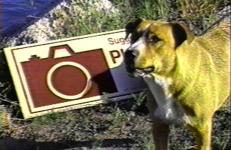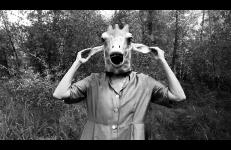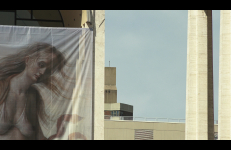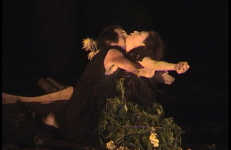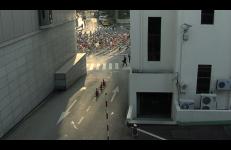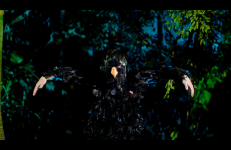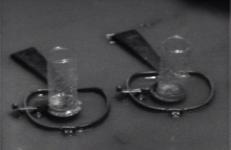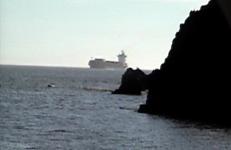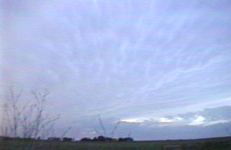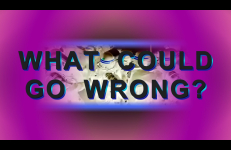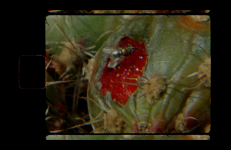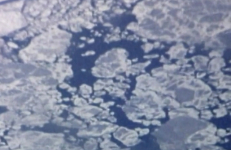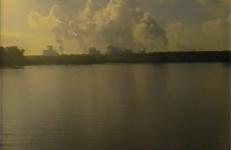Appealing concurrently in this video essay to various meanings of the term “Subatlantic” — a climatic phase beginning 2,500 years ago, as well as the submerged regions of the Atlantic — Biemann immerses her camera deep in oceanic waters to ponder upon the entanglements of geological time with that of human history.
Environment
Strap on your seat belts and get comfortable for a 7,000 mile drive. This documentary invites you to travel along with the Center for Land Use Interpretation as they find suggested photo spots across North America. Journey from coast to coast, stopping long enough to take snap shots of unusual or exemplary land use sites across North America. You will even get to take a picture of Kodak's own waste water treatment plant in Rochester, New York.
Sunday, 6th April 11:42 a.m. is a video about landscape as a complex network of connections that guide relationships between people. It is a video that focuses on the relationships between actions and places, movements and the environment as well as the trajectories which the place itself creates. The video underlines the reciprocal connection between environment and its inhabitants, because territory plays an inevitable role in its anthropomorphic transformations.
-- Flatform
Tales of a Future Past is a video about a giraffe and a zebra who fight over an undefined baby creature, in hopes of making it one of their own species. Using toy masks and a sparse theatricality, Cecelia Condit creates a contemporary reflection on species extinction and the lonely, silent world that will ensue from it.
Taking its title from the four consonants of the ancient Hebrew name for God, Tetragramaton contemplates the relationship between man, technology, and ecological systems. The sweeping camera movements, sudden changes of scale, and layers of natural and man-made sound, result in a visceral, turbulent and hypnotic dialogue between the artist's camera and the environment.
This title was in the original Castelli-Sonnabend video art collection.
Jem Cohen assembles images that demonstrate the economization of public space; the stock exchange on a LED display board, the company logo on cars, the mobile phone as tool of e-commerce. This Climate is not about the change of weather but the change of mental constitution.
I live in the Hudson Valley near the Hudson River. Historically, Muhheakunnuk, a river that runs both ways was a waterway for the colonization of North America. This film combines old footage I shot of the river in winter when the ice flowed with a live video/audio synthesizer performance as a meditation on settler colonialism and its ecosystem.
— Les LeVeque
The 1949 Housing Act, often seen as the beginning of urban renewal, reshaped the landscapes of many American cities. One of the nation’s largest urban renewal projects was the Lincoln Square Title I Project in New York City led by the powerful public official Robert Moses, which created Lincoln Center for the Performing Arts along with Fordham University’s Manhattan Campus and middle- to high-income housing. The area selected for the project was a working-class, predominantly Black neighborhood with a large population of Puerto Ricans.
This video retells and disorders an important of a pre-Columbian Native American city directly across the Mississippi River from modern St. Louis, Missouri: a location that is visited, preserved, and endlessly repeated via prescribed routes and prerecorded narratives. Rather than strive for originality, my intention is to work with found audio so as to displace these repetitions.
Producer/ Director: Sabine Gruffat
"A personal guided tour of the largest prehistoric city North of Mexico.” - Anonymous
In a remote area of northern Spain, the wind has a name: Tramuntana. Tramuntana takes what it wants—clothes, trees, boats, and the people of the landscape who live with the endless threat of being carried away by its force. This film is a lyrical portrait of this furious wind, woven from the stories passed down by local villagers.
Sound mix and design by Julian Flavin, Color by Ye Xi, Graphic Design by Studio Lieneman, With the support of "la Caixa" Foundation
In Tree Song, Eiko & Koma continue their exploration of the body as a part of the landscape and the landscape as an extension of the body. Trees have been symbols of resilience, rebirth and portals through which spirits pass. Tree Song honors the iconography of trees and the primal mysteries of landscape and the human body.
Originating from personal affection toward Seoul, Twelve Scenes portrays the spectacles in daily life by juxtaposing urban space in a twelve month sequence. As the individual particles in a kaleidoscope create splendid illusions by being reflected on a mirror, Twelve Scenes shows our individual life, seemingly separated by time and space, actually composes the scenery in the kaleidoscope of Seoul. Twelve Scenes represents a 'moment for self-reflection' or 'small, but precious enlightenment on life'.
This observational documentary presents Venice as a city inundated with tourists as well as periodic bouts of high water. The tourists take pictures, and endure the flooded areas of Piazza San Marcos. On the canals, tourists ride in gondolas while workers collect the garbage, and others deliver building materials. In the fog we approach the Rialto Bridge and then move on towards Saluti. Here a ritual procession is in progress, an event held every year since 1643 when the plague ended.
Alone in an Oklahoma motel room with a mute companion, the talkative one speaks the language of memory as pussycats feast from a canned cornucopia. Murals plaster the vacancy intrinsic to American angst as horse tails whip from annoyance the nagging gnats of tomorrow’s dung: a heap of uncertainty made impotent by the swashes of chipped paint that depict a netherworld of faded dreams and nostalgic neurosis for the future impaired.
A documentary fiction inspired on the first accounts of the natural and ethnographic explorations in America by colonizers, missionaries, and scientists. Shot in the Tropical Greenhouse of Lille, France, the film uses both the architecture and the plants of this enclosed botanic garden as narrative supports for an exploratory journey. Led by the voice-over of an explorer, the film explores the notion of exoticism, evokes the violent origins of the so-called "New World" and the endurance of the imagery they engendered.
In this early black and white, reel-to-reel video, small game traps are set to catch the rain.
This title is also available on Sympathetic Vibrations: The Videoworks of Paul Kos.
A trip to the Marin headlands at the Golden Gate of San Francisco Bay headlines this video diary. The viewer gets to eves and eye drop on various verbal and real time activities that are of a wet nature now and then. There’re boats and bodies and some spoken unspeakables amid the splendor of natural and unnatural expressions befitting the rim of a pacific paradise at low tide.
“The tape ultimately addresses all the big questions — death, origin and family, religion — as well as the small discomforts of the body, only to reverse their order of importance.”
— Margaret Morse, Framework (Los Angeles Contemporary Exhibitions)
In a motel in El Reno, Oklahoma, George observes the weather and copes with leaking air conditioning, food shopping, loneliness, television, and eating, among other things.
Scenes from a vacation. Music comes on loud and clear and washes over a series of visual impressions of the land and the sky and the faulty plumbing that submerges porcelain bottoms in a sea of unmentionable froth.
This title is also available on The World of George Kuchar.
What Could Go Wrong depicts fire trucks, ambulances, fire alarms with sonic distress that document every current disaster….floods, fires, war, food scarcity and police torture are accompanied by Linda Mary Montano singing 7 ballads. The sappy positivity of the songs and the Vision of Mary bring a suggestion that hope is possible. This video is a study in contrasts and when the audience is invited to auditorially interact with it, the message is "action breeds healing" and if so "what could go right."
Why Not A Sparrow is about a girl who enters a fairy tale land where the distinction between human and other animal species is blurred. In this kingdom, survival and extinction are on the tip of every birds’ tongue.
"An Eco-Fable about a girl, a rare bird, who experiences the pleasures and perils of another animal kingdom."
— Big Muddy Film Festival, 2002
Through the floating garden, into the mountain of signs and chants, arise the path of the winged stone. A stone that used to be a fossil.
An experimental documentary video project about individuals who have been transformed from so called “ordinary” citizens into activists, Witness To The Future seeks connections that unite people of all cultures, communities, races, and economic classes as they struggle for environmental and social change.





